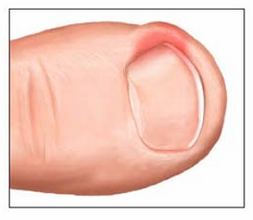Ingrown toenail
Description ingrown toenail
The operation involves the removal of the toenail, which grows into the skin, causing pain.

Reasons for removal of an ingrown toenail
Can be remove the entire nail or a portion of the nail, which grows into the skin . This is most often done to:
- Relieve pain;
- Reduce swelling (with inflammation or infection);
- Remove deformed nails;
- Correct wrong nail growth.
Possible complications of ingrown nail
If you plan to remove the ingrown toenail, the doctor will consider the risk of complications, which may include:
- Infection;
- Excessive swelling or bleeding.
Factors, that may increase the risk of complications:
- Diabetes;
- Circulatory problems.
How is removing the ingrown toenail?
Preparation for the procedure
- Wear comfortable clothing and shoes free;
- It is necessary to arrange a ride home after surgery.
Anesthesia
Local anesthesia, which has anaesthetic area operations. During the operation, the patient is in a State of wakefulness. Typically, anesthesia is given as an injection.
Describes how to remove ingrown toenail
We introduce a local anesthetic, to relieve pain quickly foot. Using special tools, the doctor cuts the nail down, the cuticle (the lower part of the nail). Then either the entire nail, either part of the nail will be removed. The cuticle can be applied with a special chemical substance, to prevent ingrown toenail.
How long will it take to remove ingrown toenail?
Less than 1 time.
Ingrown toenail – Will it hurt?
Some pain occurs, When the doctor enters the anesthetic in the finger. During the removal procedure you will not feel pain, There are feelings of pressure and stress.
Pain may occur after treatment. In this case, the doctor will provide painkillers.
Care after removing the ingrown toenail
When you return home, Follow these steps:, to ensure the normal recovery:
- Do not carry the weight of the body on prooperirovannuû leg;
- If necessary, you need to take pain medicine;
- Keep your legs above the head, where possible;
- We need to ask the doctor, when it is safe to shower, bathe, or to expose the surgical site to water;
- If your doctor will prescribe, immerse your feet in warm water for 10-20 minutes. Do this 2-3 times a day for one week;
- Apply a clean, dry bandage on his foot during the first few days after surgery;
- Wash your hands before ligation or caring for your nails;
- Wear cotton socks and shoes free within two weeks after surgery;
- Do not run and do not engage in strenuous activity, not yet earned. Maybe, you have to wait two weeks;
- Be sure to follow your doctor's instructions;
- If the toe is infected:
- Use a cream or ointment, containing antibiotics, as indicated by a physician;
- Do not apply antibiotic finger. Instead, place a small DAB of cream on a clean swab and apply the medicine on your finger;
- Take all medications as intended;
- In future, avoid ingrown nails:
- Don't wear high heels or shoes, that bad sitting on the leg;
- Trim toenails straight across.
Complete healing takes about 2-3 weeks. If you deleted the entire nail, It grows stiff leather. After, as the skin will cover sensitive area, You can return to daily activities.
Contact your doctor after the removal of the ingrown toenail
After returning home, you need to see a doctor, If the following symptoms:
- Signs of infection, including fever and chills;
- Redness, edema, increased pain, bleeding or discharge at the surgical site;
- Melovo-white, blue, black leather on your toes or foot.
